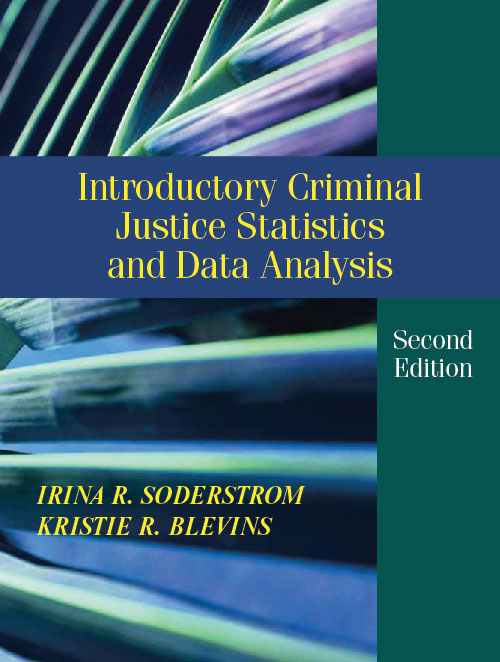"It is a great book at a good price." — Bert Burraston, University of Memphis
"I like the layout of each chapter. The multiple-choice questions at the end of chapters are a nice review and checkpoint for students. Overall, a well-rounded and well-written book." — Elizabeth Maier, University of Central Oklahoma

273 pages, $40.95 list
1-4786-2709-3
978-1-4786-2709-8
© 2016
paperback
Instructor's resource materials available here
To obtain a username and password to access these materials, contact comps@waveland.com.
To obtain a username and password to access these materials, contact comps@waveland.com.
eBook availability
Introductory Criminal Justice Statistics and Data Analysis
Second Edition
The latest edition of this user-friendly statistics and data analysis text is enriched by updated material and the successful teaching and research experiences of the lead author and new coauthor, Kristie Blevins. Their goal is to help students understand the logic of statistical reasoning and expose them to a variety of research situations in the context of criminal justice. The authors present basic statistical principles and practices on which students build knowledge and data analysis skills. Both mathematical procedures and guidelines for using SPSS to manipulate information are included.
Straightforward explanations and meaningful examples strengthen the concepts for those seeking a solid foundation for conducting scientific research and learning how to interpret and write up results. Multiple-choice questions and SPSS project assignments reinforce how statistical knowledge can be applied to the field of criminal justice. Introductory Criminal Justice Statistics and Data Analysis is an essential tool for criminal justice departments and programs wishing to build strong quantitative components in their curricula.
Straightforward explanations and meaningful examples strengthen the concepts for those seeking a solid foundation for conducting scientific research and learning how to interpret and write up results. Multiple-choice questions and SPSS project assignments reinforce how statistical knowledge can be applied to the field of criminal justice. Introductory Criminal Justice Statistics and Data Analysis is an essential tool for criminal justice departments and programs wishing to build strong quantitative components in their curricula.
Reactions
Section 1: DESCRIPTIVE STATISTICS
1. Introduction to Statistics
Why Study Statistics? / Learning to Think Statistically / The Role of Statistics in Scientific Inquiry / Basic Elements of Statistics / Levels of Measurement / Summary
2. Displaying and Graphing Distributions
Frequency Distributions / Graphing and Charting Distributions / Summary
3. Descriptive Statistics: Measures of Central Tendency and Dispersion
Importance of Quantitative Descriptive Statistics / Measures of Central Tendency / Measures of Dispersion / Summary
4. The Normal Curve and Standard Scores
The Normal Curve / Standard Scores (z-Scores) / The Standard Normal Curve / Summary
Section 2: INFERENTIAL STATISTICS: Tests of Group Differences
5. Introduction to Inferential Statistics
Probability Sampling / Sampling Distributions / Confidence Intervals / Summary
6. Hypothesis Testing
Role of Hypothesis Testing in Criminal Justice Research / Methods of Hypothesis Testing / Type I and Type II Errors / Statistical versus Practical Significance / Summary
7. Nonparametric Tests: Chi-Square Tests
Purpose and Types of Chi-Square Tests / Research Examples / The Chi-Square Goodness-of-Fit Test / The Chi-Square Test for Independence / Summary
8. Mean Difference Tests: t-Tests
Purpose of t-Tests / The One-Sample t-Test / Important Concepts Related to Independent and Dependent Samples t-Tests / The Independent Samples t-Test / The Dependent Samples t-Test / Summary
9. Significant Differences: One-Way Analysis of Variance (ANOVA)
Purpose of ANOVA Tests / Important Concepts Related to Analysis of Variance / Research Example / Post Hoc Probing / Summary
Section 3: INFERENTIAL STATISTICS: Tests of Association
10. Significant Relationships: Bivariate Correlation
Purpose of Tests of Association / Important Concepts Related to Bivariate Correlation / Statistical Significance versus Practical Significance / Summary
11. Significant Relationships: Simple Linear Regression
Purpose of Simple Linear Regression / Important Concepts Related to Simple Linear Regression / Five-Step Model for Hypothesis Testing / Summary
12. Significant Relationships: Multiple Linear Regression
Purpose of Multiple Linear Regression / Important Concepts Related to Multiple Linear Regression / Types of Multiple Linear Regression / Handling Nominal Level Variables / Summary
Appendices: Statistical Tables
1. Introduction to Statistics
Why Study Statistics? / Learning to Think Statistically / The Role of Statistics in Scientific Inquiry / Basic Elements of Statistics / Levels of Measurement / Summary
2. Displaying and Graphing Distributions
Frequency Distributions / Graphing and Charting Distributions / Summary
3. Descriptive Statistics: Measures of Central Tendency and Dispersion
Importance of Quantitative Descriptive Statistics / Measures of Central Tendency / Measures of Dispersion / Summary
4. The Normal Curve and Standard Scores
The Normal Curve / Standard Scores (z-Scores) / The Standard Normal Curve / Summary
Section 2: INFERENTIAL STATISTICS: Tests of Group Differences
5. Introduction to Inferential Statistics
Probability Sampling / Sampling Distributions / Confidence Intervals / Summary
6. Hypothesis Testing
Role of Hypothesis Testing in Criminal Justice Research / Methods of Hypothesis Testing / Type I and Type II Errors / Statistical versus Practical Significance / Summary
7. Nonparametric Tests: Chi-Square Tests
Purpose and Types of Chi-Square Tests / Research Examples / The Chi-Square Goodness-of-Fit Test / The Chi-Square Test for Independence / Summary
8. Mean Difference Tests: t-Tests
Purpose of t-Tests / The One-Sample t-Test / Important Concepts Related to Independent and Dependent Samples t-Tests / The Independent Samples t-Test / The Dependent Samples t-Test / Summary
9. Significant Differences: One-Way Analysis of Variance (ANOVA)
Purpose of ANOVA Tests / Important Concepts Related to Analysis of Variance / Research Example / Post Hoc Probing / Summary
Section 3: INFERENTIAL STATISTICS: Tests of Association
10. Significant Relationships: Bivariate Correlation
Purpose of Tests of Association / Important Concepts Related to Bivariate Correlation / Statistical Significance versus Practical Significance / Summary
11. Significant Relationships: Simple Linear Regression
Purpose of Simple Linear Regression / Important Concepts Related to Simple Linear Regression / Five-Step Model for Hypothesis Testing / Summary
12. Significant Relationships: Multiple Linear Regression
Purpose of Multiple Linear Regression / Important Concepts Related to Multiple Linear Regression / Types of Multiple Linear Regression / Handling Nominal Level Variables / Summary
Appendices: Statistical Tables